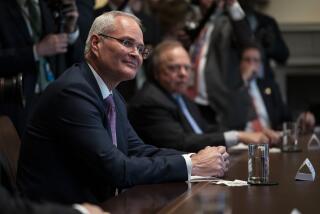Investors Got Help in Cases Against Lloyd’s
- Share via
WASHINGTON — Influential business leaders and affluent campaign donors pursued a five-year lobbying blitz in an effort--eventually successful--to persuade the government to intervene on their behalf in the complex Lloyd’s of London case, an Associated Press investigation has found.
Facing losses estimated at $200 million, the U.S. investors in Lloyd’s first pleaded with Congress, the Securities and Exchange Commission, the FBI and even the American Embassy to investigate claims that the British insurance firm had committed fraud. After being rebuffed at the federal level, the investors turned to state regulators and set up a national campaign to file complaints at the local level.
In Tennessee and California, they hired law firms to assist regulators. In California, they gave regulators the use of a private law firm’s paralegals, created a CD-ROM of legal documents and bought software so state attorneys could use the disk.
“It took three years for us to win our first battle,” said Henri Wedell, a Memphis stockbroker and outspoken critic of Lloyd’s. “And it wasn’t until the states got involved that we made any headway. The states have saved our bacon.”
The investors defend the lobbying, saying they exercised their rights as citizens to ask the government to intervene when they were wronged. State regulators insist they were doing their job--coming to the aid of citizens wronged by a company and lacking other remedies.
But the states chose to pursue a case that benefited just 3,000 investors--many of them affluent business people--at a time when regulators lack the resources to police matters affecting millions of smaller investors.
“It doesn’t seem to fall in line with their aggressive history with penny stocks, financial planners or affinity fraud,” said Barbara Roper, a securities industry expert for Consumer Federation of America.
The states’ intervention was unusual in other ways: an investigation of a foreign entity--a first--doing business in insurance, which some argue is outside their jurisdiction.
The case arose after Britain-based Lloyd’s incurred losses of $12.4 billion in the late 1980s and early ‘90s because of huge losses from pollution and natural-disaster claims. Investors claim losses also were due to the dealings of unscrupulous market insiders.
American investors--personally liable for Lloyd’s debts, as are all Lloyd’s investors--had signed papers agreeing to litigate any disputes in Britain, not in U.S. courts.
“So they were either going to be completely at the mercy of Lloyd’s, with no leverage, or their local regulators were going to affirmatively take up their charge,” said Neal Sullivan, director of a state coordinating group called the North American Securities Administrator’s Assn.
Sullivan said he isn’t surprised that some Lloyd’s investors had a highly organized lobbying effort, but says lobbying also came from “other state agencies” such as local insurance regulators, which didn’t want state securities regulators to act.
“The states would suggest to you quite the contrary, [that] they bucked the political heat and pressure,” Sullivan said.
Regulators believe Lloyd’s violated securities laws when recruiting U.S. investors. The 308-year-old institution strongly denies it is guilty of any wrongdoing.
Beginning last fall, regulators in 12 states filed lawsuits or administrative orders against Lloyd’s, seeking to prevent it from drawing money from individuals to cover insurance losses. A lawsuit in California was thrown out.
Last week, Lloyd’s and 34 states reached agreement to shave the debts of U.S. investors by 23% if they chose to join a global Lloyd’s restructuring plan.
At least eight states that rejected the deal plan to continue legal action; the rest are undecided. Who are the 3,000 U.S. investors? Lloyd’s and regulators refuse to release a list. The AP found the identities of 220 by checking court records. Of those, 52 had contributed a total of $264,000 to federal campaigns since 1991.
Overall, the investors generally lived in well-off neighborhoods, and their typical household income was $40,729, or about 26% above the national average, according to a comparison of investors’ ZIP codes with U.S. Census Bureau data.
More to Read
Inside the business of entertainment
The Wide Shot brings you news, analysis and insights on everything from streaming wars to production — and what it all means for the future.
You may occasionally receive promotional content from the Los Angeles Times.










